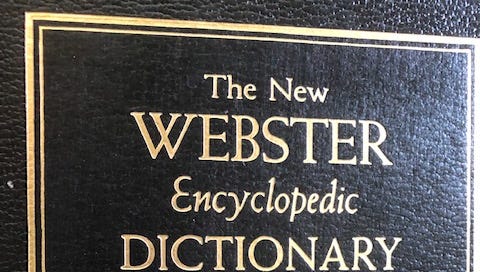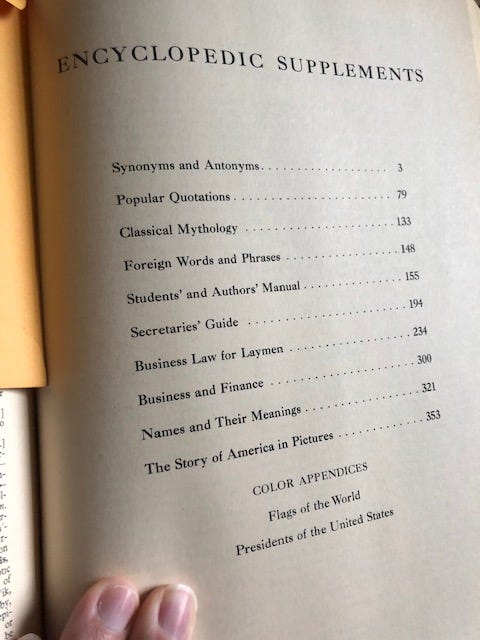One of the things I was gifted on my birthday was a book from my aunt’s house. There was a copy of The New Webster Encyclopedic Dictionary that was published in my birth year. My mother found it while cleaning out the bookshelves, and decided no one else would want it. She was more or less correct with that. This is a big ten-pounder of a book, and while it had value as a dictionary back then, it was probably used as much for that as much for its “Dictionary of Synonyms and Twelve Supplementary Reference Sections” which filled the last quarter of the book.
This was probably originally bought for the car dealership which adjoined the house, for effective business communications. The sections “Secretaries’ Guide,” “Business Law for Laymen,” and “Business and Finance” are the only ones that show any signs of wear. I would wager that this spent a few years next to the typewriters on the desks in the leasing company as most of its features were slowly absorbed by first word processors and then the internet.
The point that’s interesting for my purposes, and for the purposes of the book, is that this dictionary would have had the same level of entry into the rooms of question writers as almanacs, and you can see where both the dictionary and its supplemental sections could have been plumbed for questions. If you think about the contents of early questions in both quiz bowl, radio and television programs, and the like, it’s that lots of questions match categories that could be generated and verified from such dictionaries. A dictionary or almanac would have been present in a lot of places that other sources would not have been present. As such, they would be relied upon in situations where the time and effort required to go down to the library would not have been feasible. A dictionary would also have been something that they would use to proof their own questions before submitting them, so as long as they had a set location where they wrote, it’s likely a dictionary would be within reach.
From the dictionary side come much of the vocabulary and the dreaded spelling questions that were present in competitions, but have diminished. One of the key things that this dictionary has are word origins for every entry, which are clues in themselves. Many of the non-business-applicable supplements in this list actually read like categories for a game show. The synonyms and antonyms could be combined with word origins for the kernel of a question. The “Popular Quotations” section covers literature by giving the quote, author, and work, again the kernel of a question. The sections on Presidents, mythology, and names could be mined easily for questions, and the “Business and Finance” section contains a few pages on arithmetic which could be used to create computation questions.
It’s not to say that this particular version was used, but that a single-volume reference source like this was not uncommon, and would be handy to a writer or group of writers in a way that other more specialized or detailed sources were not. As such it helps to put into context the types of questions which would have been common when television quiz bowl began. Since one of our pet theories in the book is that the next match’s questions resemble the last match’s questions, we can see the pieces that were present at the beginning and have survived. Understanding that lineage helps to predict what will be coming up.
For any large-scale writing project, like a set of television quizzes, the supply of creativity will be dwarfed by the demand. Creatively written questions take time and energy, and often the writer is so enamored of their work that they take their time in perfecting the question, leaving them behind schedule and needing to work when their spark has been exhausted. Creativity is unpredictable, we don’t know what can inspire someone’s creativity, anything at all can be a spark, so it doesn’t give us much to work with in predicting what the writer will write. But once a writer exhausts their creativity, they will turn to other sources for inspiration, and they will start with what is within arm’s reach first. And what was in proximity to a writer in that era WAS somewhat predictable, and those patterns will have echoes in today’s television questions.
I actually didn’t get around to watching the new season of College Bowl until Monday, a side effect of Catie’s now having to attend football games for band. I’m going to dissect the new round that was added in a moment, but I wanted to note that how they’ve taken advantage of the ability to set their field and book matches to appeal to the market.
In the first season, the show matched up teams from Alabama and Auburn in the preliminaries, and this year they paired Georgia and Florida, and Oklahoma and Texas in first round matches. This allowed them to exploit historic rivalries in football to provide a bump in interest in the match. The move to Friday nights in September also permitted another method of pumping up rivalries, in that a match between Notre Dame and Ohio State aired a week after they met on the football field. While this was clever, it might have worked better if it had aired the night before the match. That might have even been the intent, but scheduling in advance is an inexact science. I could see a season 3 schedule that used kickoff matches and week 2 and 3 out of conference matches to promote the College Bowl match in advance. (NOTE: something like this could be done by college circuit teams, as a method of promoting both teams to their campuses. It even has precedent: In the 90’s, Stanford and Berkeley played a series of annual quiz bowl scrimmages the week of “The Big Game.” With everyone now familiar with online competition this is something that could be done to promote competition, and give teams something to enhance visibility and recruitment on campus. I thought of this briefly during The Backyard Brawl, two weeks ago, and this is kind of a note to my future self to try to set that up next year.
I don’t believe that high school competitions use this technique to set up matches, or really can use this technique except in special cases. The one case I knew was set up this way was when two teams from the same town were brought into the local program on the same day and the third team had cancelled on day of taping. This was mentioned in this newsletter at the beginning, as showing how a program is forced to adapt and reveal more of itself under stress. This was also convenient to the show in that both teams in the two-team match were from the same town, and coached by sisters. Whether the show intentionally put that match together on day of event or it was simply a situational decision, it allowed the match to go on, and gave the station material to fill in the time that would ordinarily be occupied by a third team.
The format has changed from the previous year, with minor changes to two rounds from preliminary, and one major shift in the new round.
The format of the first round has changed to always fill in the chosen category with a new one, and to remove the possibility of bounceback on the second and third questions of the subject. The former change allows them to conserve questions, since unchosen categories could be brought back later, while the latter change shaves a few seconds off the question cycle.
The notable change of the Two-Minute Drill is that the buzzer must be hit to answer, but that doesn’t stop the moderator. This is interesting in that it basically makes the buzzer an obligation, but something that teams were simply buzzing at the beginning of the question and running with it. The other interesting bit was in the first match of each episode the Two-Minute Drill, it was especially obvious the two sets were written in parallel. If you got a question with an acronym in the seventh question asked, your opponent got a question with an acronym for their seventh question. This was much less apparent for some reason in the second match of the episode. Whether this was design or happenstance, I can’t say, but it would suggest the possibility that there are two stacks, set in parallel to each other, but the stacks extend through from the previous match. Also, as I had mentioned about lightning rounds, this means there’s a slight advantage to going second in the Two-Minute Drill, if you can see the pattern of questions from your opponent’s round, you can prepare your mind to be aware of the traps they fell into.
The new round, One on One, is a case study for having your team be diversified in expertise. The setup is to have to choose one player from your team to handle each of a set of categories. While the categories are sufficiently vague as to be unhelpful if you’re trying to play to your strengths, it may be easier for a team to position their players such that their hole subjects are not used in a one-on-one match. Because the writers are using given category names as vaguely as possible, or interpreting categories in different ways for different questions, you may only hit on one interpretation of the category matching your strength in that category, leaving you susceptible to playing weakly on the other two questions. It may be a better strategy to just think “Are any of these categories something I have no chance at, no matter what the category means?” and position your team so that each player dodges the worst.
I’m hesitant to call this all the changes after just the quarterfinals, because I was burned by that last year, but these changes do seem to save both time and questions, while still giving the players the chance to distinguish themselves and establish rapport with the audience in gameplay, rather than in banter with the hosts. That smooths out a lot of the issues that those familiar with the competition had noticed, without making it inaccessible to the general public.




